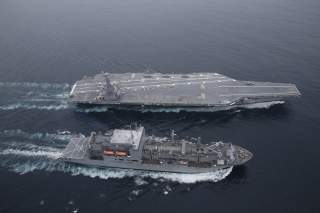Why America's Navy Should Cut Back on its Global Commitments
A much smaller fleet is being pushed to do an even more demanding job due to today’s more challenging security environment.
The United States Navy is stretched too thin and should scale back its commitments around the globe.
As present, the fleet is simply too small to do what is being asked of it and the service must sometime put its foot down and say no. It’s likely the only way to prevent the kinds of accidents we have seen in the Western Pacific over the past year where overworked and undertrained crews have made serious errors that have resulted in damaged ships and serious loss of life.
“The Navy's been run hard in the past 16 years of war and the pace is picking up, especially in the Pacific,” Adm. John Richardson, chief of naval operations, told reporters at the Pentagon on November 2. “Recent experience has shown that if we're not careful, we can become overstretched, overextended. And if we take our eye off the fundamentals, we become vulnerable to mistakes at all levels of command.”
Those errors have led to a number accidents, most notably collisions involving the Arleigh Burke-class destroyers USS Fitzgerald and the USS John S. McCain, which cost the lives of ten of sailors. Richardson did not pull any punches during his briefing.
“I'll be clear, these accidents were preventable,” Richardson said. “The causes for the collisions included a failure to plan for safety, failure to adhere to sound navigational practices, failure to execute basic watchstanding principles, failure to properly use available navigation tools, failure to respond deliberately and effectively when in extremist of collision, a loss of situational awareness and high traffic density, failure to follow the international rules of the road and for John S. McCain, insufficient knowledge and proficiency of the ship’s steering system.”
After the collisions, the Navy completed a comprehensive review that has shown that over the course of the past decade, standards have slipped as the number of ships in the fleet has grown smaller and the operational tempo has grown more intense.
“The comprehensive review found that over a sustained period of time, rising pressure to meet operational demands led those in command to rationalize declining standards, standards in fundamental seamanship and watchstanding skills, teamwork, operational safety, assessment and a professional culture. This resulted in a reduction of operational safety margins,” Richardson said. “Further, the demand for ready and certified ships to support operations exceeded the quantity to be supplied lacking an effective process clearly defined, available supply and associated readiness. Steadily increasing risks were not understood or appropriately mitigated as the ships were routinely assigned to high priority, short notice tasking.”
The Navy is starting to take actions to fix the problem, but it will take time. However, the underlying issue is that the fleet is massively overburdened. “There are 100 ships and 64,000 sailors and Navy civilians forward deployed. This includes three carrier strike groups and their embarked air wings, three amphibious readiness groups, and their embarked Marine expeditionary units, six ballistic missile defense ships on station, 11 attack submarines, five SSBNs,” Richardson noted. “The vast majority of these ships are conducting their missions, some of them extremely difficult, effectively and professionally, protecting America from attack, promoting our interests and prosperity, and advocating for the rules that govern the vast commons from the seafloor, to space, and in cyberspace.”
The problem is that while 20 years ago the U.S. Navy had just over 330 ships with about 100 ships underway at any one time, today’s much smaller fleet has roughly 276 ships with about 100 vessels deployed. That means a much smaller fleet is being pushed to do an even more demanding job due to today’s more challenging security environment with less people and 55 fewer ships.
Until now, the Navy has had a culture where commanders and sailors would simply say ‘yes’ to whatever mission or tasking they were assigned even if they had to cut corners to make it happen. Richardson said that the Navy must change that culture to one where subordinates speak up if their ships and their crews are not mission ready.
“It's fundamental in the nature of command, if you're not ready to execute the mission that you're assigned, you've got to make that clear,” Richardson said. “When we fail to do that, we become vulnerable. We get assigned for missions for which we're not prepared. So we have to insure that we create a climate. This is this idea of culture that's discussed in the comprehensive review, that values these discussions, and is open and listening to those commanders that are saying that I've been stretched too thin.”
It will take time, but the Navy will have to make these adjustments—otherwise there will more accidents and more sailors won’t make it home to their families.
Dave Majumdar is the defense editor for The National Interest. You can follow him on Twitter: @davemajumdar.
Image: U.S. Navy

